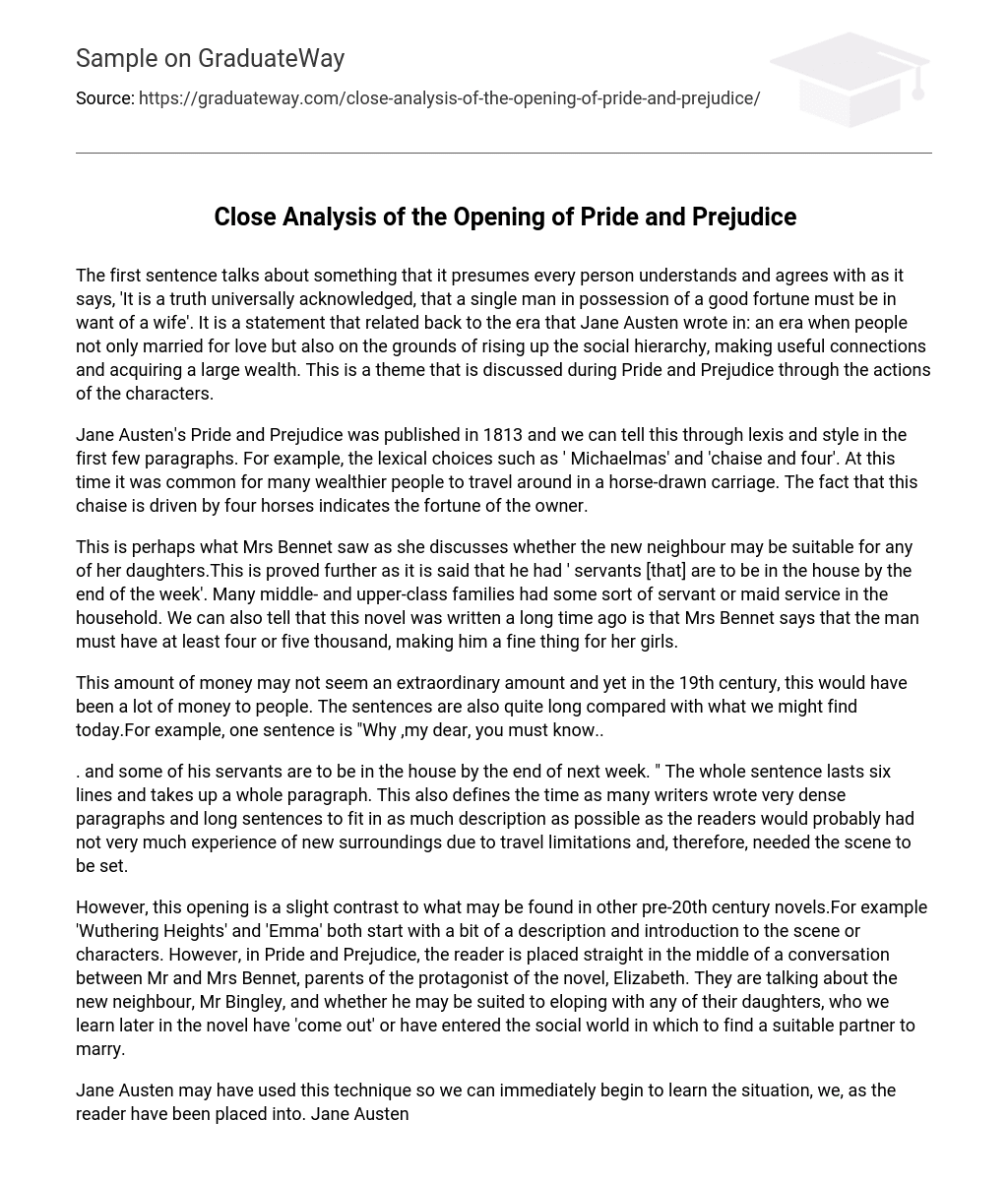The opening sentence acknowledges the common knowledge and acceptance that a wealthy single man requires a wife. Jane Austen’s novel, Pride and Prejudice, portrays the society of her era which valued marriage not only for love but also for social advancement, networking, and financial gain. The actions of the characters throughout the book delve into this theme.
In its initial paragraphs, Pride and Prejudice by Jane Austen establishes its historical setting and tone through the choice of language and style. Published in 1813, the novel utilizes terms such as ‘Michaelmas’ and ‘chaise and four’ to reflect the vocabulary of that era. During this time, it was customary for wealthy individuals to travel in carriages pulled by horses, with the presence of four horses indicating the owner’s affluence.
This is possibly what Mrs Bennet noticed while discussing the potential suitability of the new neighbor as a match for her daughters. This is supported by the mention that he had servants who were anticipated to arrive at his house by the end of the week. It was customary for families of middle and upper social standing to employ domestic assistance. Another clue indicating that this novel is set in the past is Mrs Bennet’s remark that the man must possess a fortune of at least four or five thousand, making him an attractive prospect for her daughters.
During the 19th century, the monetary value mentioned might not have seemed significant, but it would have been deemed substantial by individuals of that era. Moreover, sentences employed during that period were noticeably lengthier in contrast to what is typically observed nowadays. An instance illustrating this can be found in the sentence “Why, my dear, you must know..”.
The sentence ” . and some of his servants are to be in the house by the end of next week.” encompasses six lines and occupies an entire paragraph. This was a common practice among writers who aimed to include extensive descriptions in their paragraphs and lengthy sentences, as the readers likely had limited exposure to unfamiliar surroundings due to travel restrictions. Hence, the detailed scene-setting was crucial.
The beginning of Pride and Prejudice stands out from other novels written before the 20th century, such as ‘Wuthering Heights’ and ‘Emma’. Instead of starting with a description or introduction of the setting or characters, it starts with Mr and Mrs Bennet having a conversation. They talk about their new neighbor, Mr Bingley, and wonder if he could be a suitable match for one of their recently introduced daughters who are looking for a husband.
Jane Austen’s use of this technique allows us to quickly grasp the situation we have been placed into as readers. The careful selection of the opening conversation relates back to the novel’s first statement and one of its universal themes: love and marriage. Additionally, it introduces two main characters and provides insight into Mrs. Bennet’s talkative and nosy nature, portraying her as someone who desires the best for her daughters.
Mr Bennet is content to let his wife do the talking and only inquires about the man’s name and marital status. Jane Austen highlights Mr Bennet’s taciturn nature through phrases like ‘Mr Bennet replied that he had not’ or ‘Mr Bennet made no answer.’ This may indicate a mutual respect between the two and subtly suggests a harmonious family dynamic. However, it also underscores a role reversal.
In her novel, Jane Austen utilizes dialogue to portray the traditional concept of men as household leaders, a belief that continues to be present in modern society. Throughout the narrative, Austen consistently employs this technique while offering limited description. Despite being written in third person, the author’s personal connection with the story or characters remains ambiguous until the conclusion of the initial chapter. Nevertheless, despite this initial uncertainty, Austen provides glimpses into Mr and Mrs Bennet’s personalities, hinting at a possible familiarity with them.
The text highlights the contrasting personalities of Mr Bennet and Mrs Bennet. While Mr Bennet is known for his intelligence, sarcastic humor, and reserved nature, even his wife struggles to fully understand him. In contrast, Mrs Bennet’s temperament is uncertain and she focuses primarily on securing suitable marriages for her five daughters. This initial portrayal in the novel demonstrates Jane Austen’s talent for creating a wide range of intriguing and complex characters, allowing readers to form their own preferences, whether it be for the arrogant Lady Catherine de Bourgh or the clever and witty Elizabeth. Furthermore, we can deduce that Jane Austen herself holds some reservations about her characters.
When discussing the Bennet family, the author portrays different attitudes towards Mr and Mrs Bennet. With Mr Bennet, the author speaks fondly, as if he is a beloved friend. However, when discussing Mrs Bennet, the familiarity diminishes slightly. This is particularly evident when the author refers to Mrs Bennet as ‘Her’, creating tension between the two women. The phrase ‘its solace was visiting and news’ implies that the author finds Mrs Bennet irritatingly inquisitive and enjoys gossiping about others.
Jane Austen’s statement that Mrs Bennet “fancied herself nervous” implies that Mrs Bennet’s perception and self-image do not align with how others perceive her.





